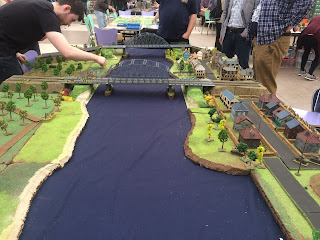Since coming back from holiday I’ve been avoiding
committing to the plastic/lead painting mountain for some reason. This
is, I know, associated with some deadline pressures at work (which I’ve
missed anyway, which makes it worse in a way
as the extensions just mean they haven’t actually gone away).
But when that
happens making and painting individual terrain pieces is what I usually turn
to, and as noted in an earlier post I have been making various 15mm desert type buildings intended for AK47, ancients (DMB) or even Mexico.
Anyway, here is one of the pieces I’ve made, a
compound that wouldn’t be out of place anywhere in Central Asia or
Africa. This is actually based on the examples you can find on the
'Takistan' terrain, originally part of the ARMA2 'mil-sim'
PC game, now ported to ARMA3 (using the CUP mod, in case you're interested).
Clearly the terrain is supposed to
represent Afghanistan, although maybe it is meant to be Tajikistan (or,
heaven forbid, the unpronounceable Kyrgyzstan).
Modelling was my usual technique of cutting strips
of thin pizza-base polystyrene which were then glued together onto a
cardboard base. Everything was painted a chocolatey earth colour and
then fine sand was stuck to the walls (with PVA
wood glue) and a coarser sand glued to the ground. Walls were then
painted in shades of sandy earthy colours with various washes to dirty
them up.
Some static grass was added in various places and a tree put into one of the corners. This is a piece of heather stem (we have a lot of it lying around in Scotland) with some of my home-made clump foliage stuck to the top.
I’ve a plan to make a whole forest of acacia trees
using the bag of heather I collected a few years ago, but haven’t got
around to it yet. Overall, the compound turned out quite well and makes
a contrast from the mainly white-walled 15mm
buildings I also made, which I will post about later. Some static grass was added in various places and a tree put into one of the corners. This is a piece of heather stem (we have a lot of it lying around in Scotland) with some of my home-made clump foliage stuck to the top.
I may make a few more of these ‘Takistan’ type buildings but we shall see how much time, inclination and not to mention storage space, I have to do that.
 |
| Russian on the roof |



















































